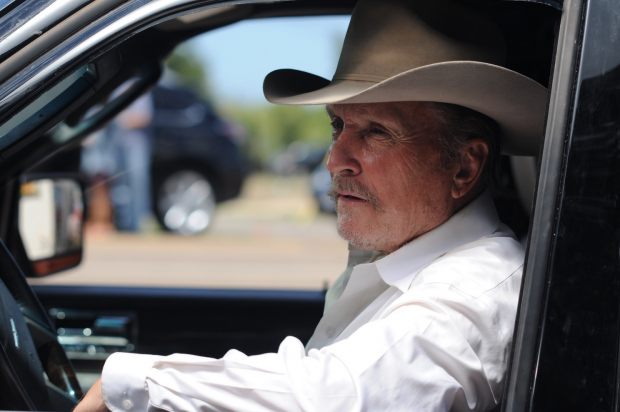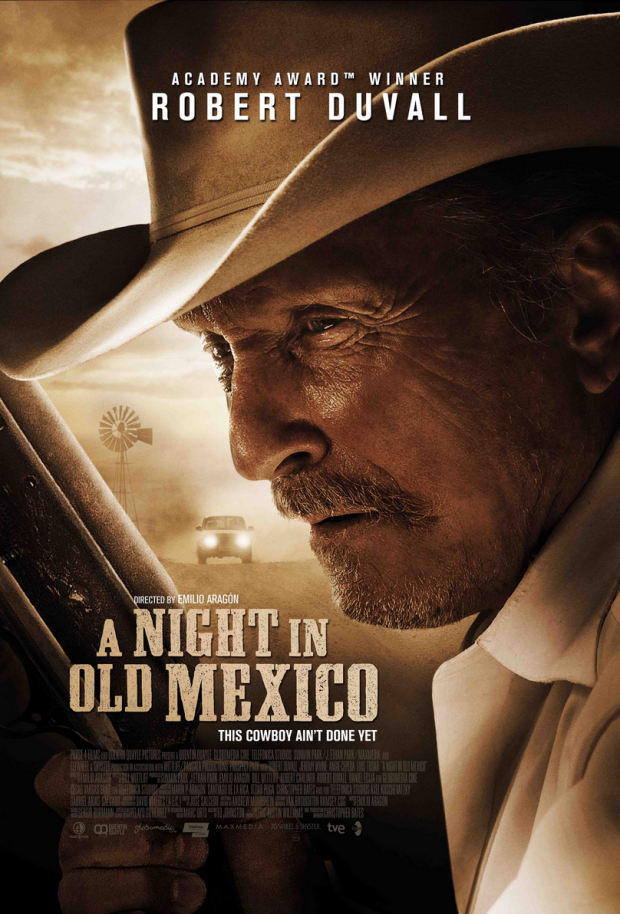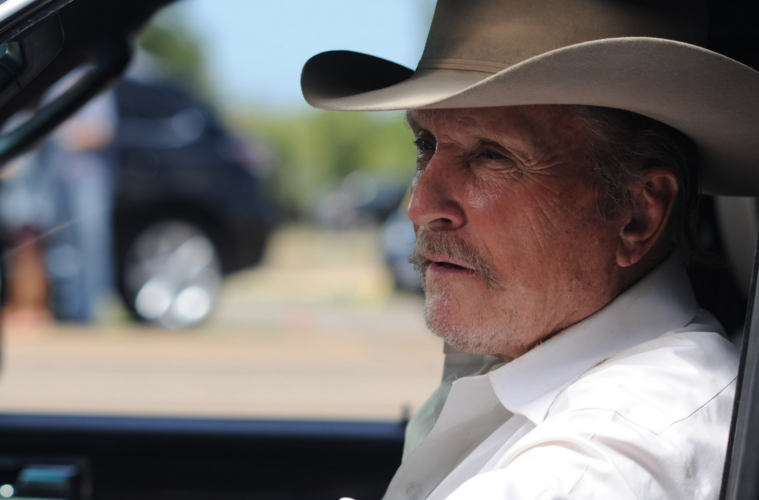
Robert Duvall is a film legend. There’s no way around it. Nowadays he’s still very much acting, funding movies he wants made, or being the headliner for a film that is a passion project of sorts, like A Night in Old Mexico. Earlier this month I had the chance to sit down with Duvall for a one-on-one interview during SXSW. While I wanted to get some questions in, I let him steer the conversation more than anything. As soon as he sat down across from me, he started opening up right off the bat when I brought up Texas. During our interview Duvall spoke about what draws him to films these days, the genesis of this project (including an early iteration directed by Dennis Hopper), the location of the film, whether he’s into cars or not, and much more. Read on for our full conversation.
Robert Duvall: I like Fort Worth a lot too. I have a lot of friends in Houston. I’m reading a big two volume book on the genesis of the King Ranch, pretty interesting. [Editor’s note: he’s referring to Bob and Helen Kleberg‘s book.] All happened around Brownsville where we did this movie — what a history. I think it’s 800,030 acres, less than a million. We had lunch there one day; the guy drove 65 miles in the ranch to feed us — he was something that guy, that king way back. He formed that with the Indians and the Mexicans, and the bad redneck Texas guy. I didn’t realize Colonel Robert E. Lee was a guest at the King Ranch — told him where to put the house and everything, before he went back East and eventually led the confederacy. He was a friend of King’s.
The Film Stage: What made you pick up that book?
I met them over the phone, the Klebergs, so I invited him today, but I don’t know if they’re going to come. The woman is like a running history lesson and they sent me this book. It doesn’t really go into the character of King, but the overall history is just wonderfully told. The Civil War and how [Ulysses S.] Grant, after the war, sent ships down to guard it. Some of the Texas troops, even though they were aligned with the Confederacy, did better so they did the attacks against the union — amazing. Back then, a lot of fighting between the Mexican and their side; now it’s worse than ever with the dope and stuff.
Just across the border, it’s basically a bloodbath…
Some nice ladies brought some Cabrito over from the other side. It was great. One of the best Mexican restaurants in Brownsville — moved from Mexico over [to here] — because the gangs hold them up and everything. That’s where that Marine, for four months, was prisoner. I know a few of the border sheriffs; good ideas, [but] tough battle trying to keep that line of demarcation.
 I have family from Brownsville. That’s where you shot on location?
I have family from Brownsville. That’s where you shot on location?
Absolutely, from Santa Fe to New Mexico. Down there the rebates are good. I loved it there. The Rio Grande valley, I love working there.
What about the car you drive in the movie? It’s an old cadillac.
Yeah! I never was into cars much. My wife is from Argentina, they drove race cars down in Argentina. I just get there. I never had that. It was interesting.
The car becomes a character in the film.
I think so.
It moves with you. It brings this Texas vibe with you.
In the beginning — that long, flat, expansive beach sand — that was all Texas.
I’m curious about your character you play in this film. You play a rancher that has fallen on hard times. Obviously Texas has gone through the drought period…
Although it’s a very prolific state. When you hit the ground you see how prosperous things look compared to other states…
You’re obviously reading the book on the King Ranch. Did you talk with any farmers or ranchers?
No. I know a few. I talked to Mr. Kleberg some. I did say to him, “What’s the most important thing about ranching?” Without hesitation he said, “rain.” My uncle, when I was a kid, he was a rancher in northern Montana. I used to go as a kid. That was the beginning of my love for horses and westerns. I didn’t know I wanted to be an actor but it served me OK.
Your character dances a lot in the movie…
Cowboys do. I was down on the border with some riders and a buddy had a big barbecue and the best dancers were the horsemen, they were the best two steppers. They sing too. They sing to the cattle in the old days. I say to my grandson in the movie, “You don’t sing. You don’t dance. What do you do?”
About the dancing, did you work out any routine?
Absolutely not. We just did it. I think we practiced once before. And the fact that the kid who plays my grandson don’t know how to do it… the younger generation don’t know waltzes or two steps or whatever. You go to these clubs, dance counter clockwise, other clubs where they dance shag in South Carolina, or the tango in clubs in Buenos Aires, counter clockwise; it’s an ethnic thing to this state. Two step and the waltz.
You’ve made quite a few films and I’m curious what draws you to a role at this point in your career?
I’ve been drawn to this role for 15 years or more. Once we said we were going to do it with Dennis Hopper directing. Then 10 years ago we were going to do it again with some French director, who just disappeared, then Emilio [Aragón] showed up, a spanish guy. I always knew I wanted to do it, but it was very difficult to get off the ground, like a lot these independent movies. It was always in the back of my mind. It was something I always wanted to play, interesting character.
It seemed you had a lot of extras on set. Did you draw from local talent?
Oh, yes. We had good people at the head of departments, expertise wise, and they hired all the extras and different people. Unless it’s Hollywood — where they are so jaded being professional extras — here, it’s like a first time thing and they were wonderfully cooperative and enthusiastic. There was one woman, behind the desk of the hotel, she wants to be an actress and they gave her a small part and she was terrific. In one of the edits they cut her out and I said you have to put that back in. She played a hooker. Her husband was on set; he was pretty jealous and he was hovering. We did use the people. There was a wonderful sense of cooperation with the people of Brownsville. The first week, the mayor, threw a beautiful brunch; Mexican food, with all the trimmings for all the cast and crew. There was a lot of cooperation with the town of Brownsville.
I take it you’ve been to Cannes and Toronto? What brought you here?
Yeah, I’ve been to all those. Somebody didn’t want this at Toronto — I’m glad, this is a Texas movie. This about my third time to this one, I’ve been to Cannes. I’ve been to Toronto a number of times. I’ve been to San Sebastian. Wonderful festival, some of the best food in the world in Spain. You look like you could be Spanish.
I’m a quarter Mexican and a quarter Cuban.
Cuban? Cubano. Oh, I have good friends in Cuba. I was there once recently doing some research.
How did you arrange that?
They arrange it through…whoever. It was OK. It wasn’t my favorite place, but you can see the beauty there still in Havana. I like the food. Best Cuban food I have ever had was in Alma de Cuba in Philadelphia. They moved from Miami, up.
A Night In Old Mexico premiered at SXSW 2014 and opens in May; one can watch a clip above.

